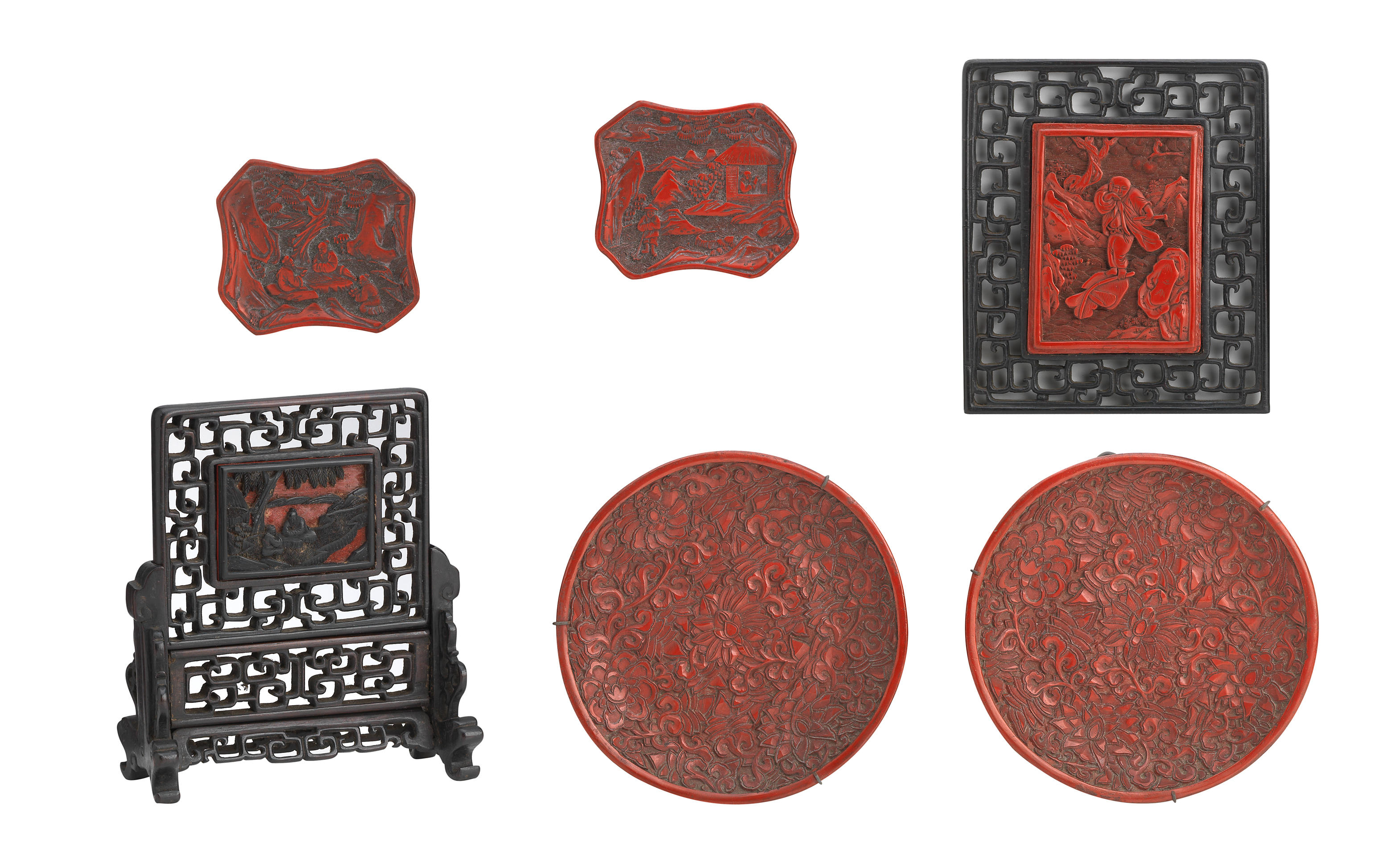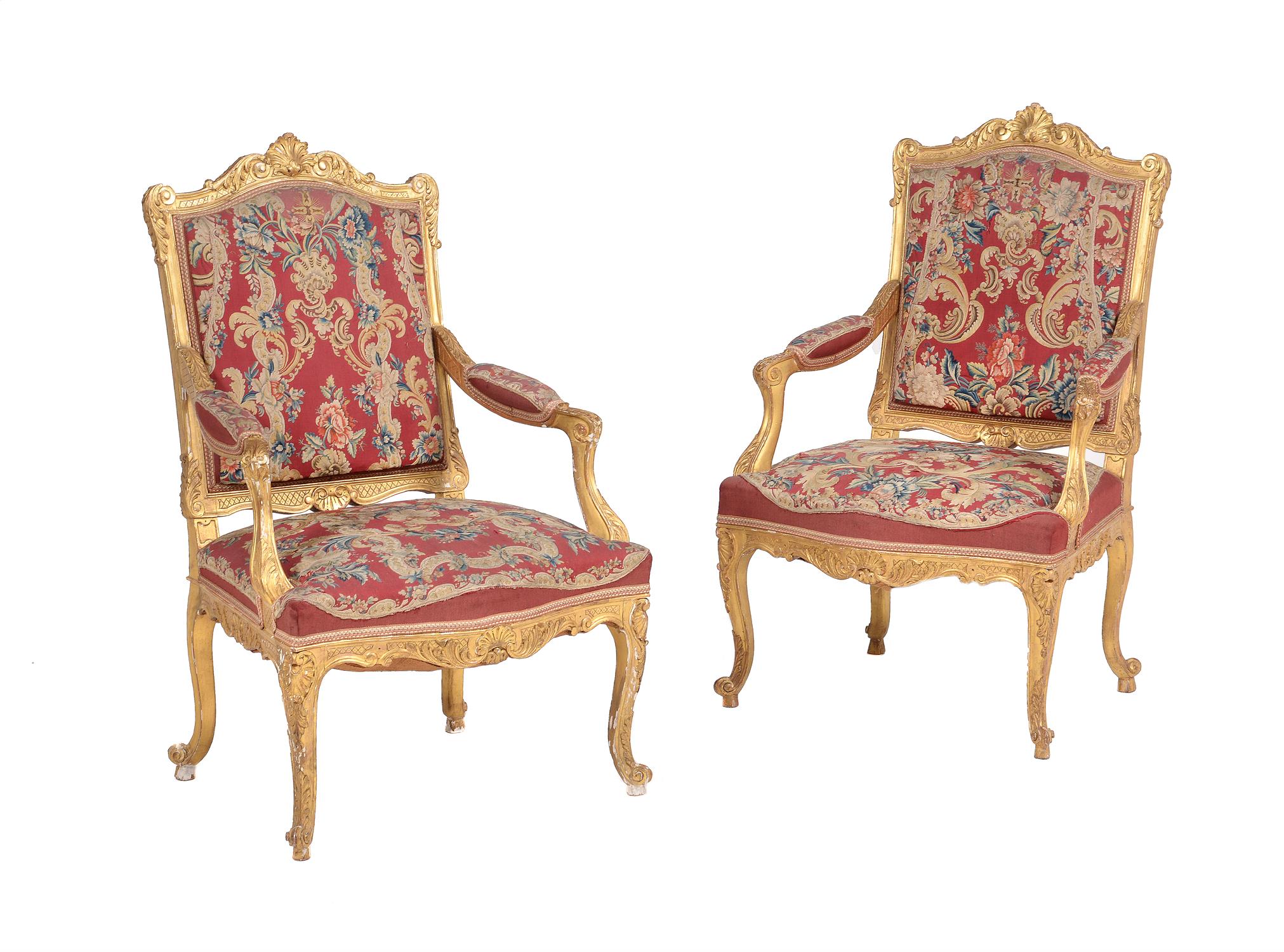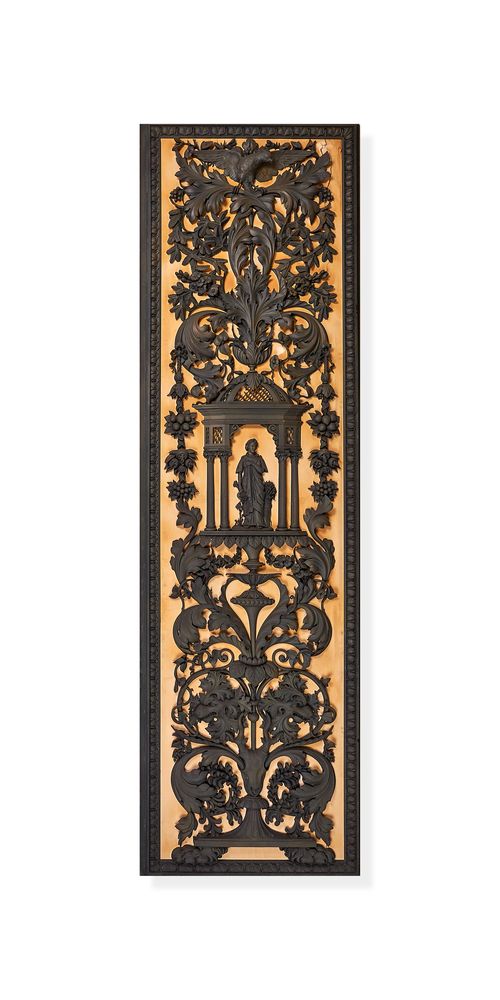A pair of carved bronzed wood panels by Anton Leone Bulletti , Florence, dated 1864, in the baroque style, featuring baldechins and goats heads each with elaborate foliate scroll carving and ivory painted grounds, each 290cm high and of varying widths between 80cm and 89cm; together with a pair of architectural spandrels , with some losses to carving, 196cm high, 180cm wide Provenance: Lartington Hall, Co. Durham Literature: Rosamond Allwood, `The Eminent Italian Artist, Signor Bulletti', Furniture History Vol. 25 (1989), pp. 250-256, figs. 2 and 3. Following a visit to Rome in 1854 the fourth Duke of Northumberland decided to redecorate the interiors of Alnwick with wood carvings in an Italianate seicento manner, under the direction of the architect Anthony Salvin This was in contrast to Salvin's chosen mediaeval style for the exteriors and rather than import the wood-work from Italy, Salvin saw this as an opportunity to set up a school of Italian style carving at the castle. It was on this basis that he invited the Tuscan carver Anton Leone Bulletti (b.1824), to be its director with the Alnwick carver John Brown acting as foreman. A total of twenty-one carvers were engaged from London, Newcastle, Sunderland, Edinburgh and Glasgow in advance of the carving studio's opening in 1855. It was here that the ornately carved doors, shutters and ceiling panels were produced for the castle. By 1860, the majority of the interior work was complete at which point Bulletti left his post at Alnwick to set up a business as a carver and draftsman at 30 High Bridge, Newcastle. One of his first commissions was for the Rt. Revd. Monsignor Witham, at Lartington Hall, Co. Durham. This followed Withham's decision to embark on an ambitious programme of building works under the direction of the architect Joseph Hanson. These included a grand entrance corridor and port cochere completed in 1863, for which Witham commissioned Bulletti to make a twelve foot high mirror frame and a series of carved wall panels including the present lot. Further carvings are thought to have been supplied by Bulletti for Thomas Witham's private suite above the servant's hall. Unlike the style of his work at Alnwick, Bulletti's work at Lartington was heavily influenced by the carvings of Giuseppe Maria Bonzanigo who produced carvings for the Royal palaces in Turin during the 1780s. In contrast to his English contemporaries such as Gerard Robinson and the Warwick school of carvers, who worked in a more three dimensional style, Bulletti's mounted his carving on panels of contrasting colour. The entrance hall mirror frame was described in the Teesdale Mercury in 1863 ... A Splendid specimen of wood carving of the highest order. In the centre of the bottom of the frame is the crest of Mr Witham supported on either side by dragons with eagle's heads. From these spring the conventional foliage, which in the present instance consists of the thistle, the convolvulus and the Primrose. About the centre of each side of the frame, the allegorical figures of two storks destroying a serpent are introduced and above these is a panel bearing on one side the date, and on the other side the motto, 'solo virtus victit'...This magnificent work of art arrived at Lartington Hall last week. Bulletti was also commissioned by the Silvertops of Minsteracres, near Consett, Co. Durham - unsurprisingly they had close connections with the Withams and similarly employed Joseph Hanson. In 1865 Bulletti moved to Newcastle's bustling Grey Street where he remained until 1869. His achievements during this period included a carved walnut table exhibited at the Fine Art Exhibition at Newcastle town hall in 1866. This was favourably received....`a magnificent work of art, poetical, vigorous in conception and design whilst manipulative skill displayed in the execution is of the most exquisite character'. However despite the table's great merit it still remained for sale in 1870 at the price
A pair of carved bronzed wood panels by Anton Leone Bulletti , Florence, dated 1864, in the baroque style, featuring baldechins and goats heads each with elaborate foliate scroll carving and ivory painted grounds, each 290cm high and of varying widths between 80cm and 89cm; together with a pair of architectural spandrels , with some losses to carving, 196cm high, 180cm wide Provenance: Lartington Hall, Co. Durham Literature: Rosamond Allwood, `The Eminent Italian Artist, Signor Bulletti', Furniture History Vol. 25 (1989), pp. 250-256, figs. 2 and 3. Following a visit to Rome in 1854 the fourth Duke of Northumberland decided to redecorate the interiors of Alnwick with wood carvings in an Italianate seicento manner, under the direction of the architect Anthony Salvin This was in contrast to Salvin's chosen mediaeval style for the exteriors and rather than import the wood-work from Italy, Salvin saw this as an opportunity to set up a school of Italian style carving at the castle. It was on this basis that he invited the Tuscan carver Anton Leone Bulletti (b.1824), to be its director with the Alnwick carver John Brown acting as foreman. A total of twenty-one carvers were engaged from London, Newcastle, Sunderland, Edinburgh and Glasgow in advance of the carving studio's opening in 1855. It was here that the ornately carved doors, shutters and ceiling panels were produced for the castle. By 1860, the majority of the interior work was complete at which point Bulletti left his post at Alnwick to set up a business as a carver and draftsman at 30 High Bridge, Newcastle. One of his first commissions was for the Rt. Revd. Monsignor Witham, at Lartington Hall, Co. Durham. This followed Withham's decision to embark on an ambitious programme of building works under the direction of the architect Joseph Hanson. These included a grand entrance corridor and port cochere completed in 1863, for which Witham commissioned Bulletti to make a twelve foot high mirror frame and a series of carved wall panels including the present lot. Further carvings are thought to have been supplied by Bulletti for Thomas Witham's private suite above the servant's hall. Unlike the style of his work at Alnwick, Bulletti's work at Lartington was heavily influenced by the carvings of Giuseppe Maria Bonzanigo who produced carvings for the Royal palaces in Turin during the 1780s. In contrast to his English contemporaries such as Gerard Robinson and the Warwick school of carvers, who worked in a more three dimensional style, Bulletti's mounted his carving on panels of contrasting colour. The entrance hall mirror frame was described in the Teesdale Mercury in 1863 ... A Splendid specimen of wood carving of the highest order. In the centre of the bottom of the frame is the crest of Mr Witham supported on either side by dragons with eagle's heads. From these spring the conventional foliage, which in the present instance consists of the thistle, the convolvulus and the Primrose. About the centre of each side of the frame, the allegorical figures of two storks destroying a serpent are introduced and above these is a panel bearing on one side the date, and on the other side the motto, 'solo virtus victit'...This magnificent work of art arrived at Lartington Hall last week. Bulletti was also commissioned by the Silvertops of Minsteracres, near Consett, Co. Durham - unsurprisingly they had close connections with the Withams and similarly employed Joseph Hanson. In 1865 Bulletti moved to Newcastle's bustling Grey Street where he remained until 1869. His achievements during this period included a carved walnut table exhibited at the Fine Art Exhibition at Newcastle town hall in 1866. This was favourably received....`a magnificent work of art, poetical, vigorous in conception and design whilst manipulative skill displayed in the execution is of the most exquisite character'. However despite the table's great merit it still remained for sale in 1870 at the price















Testen Sie LotSearch und seine Premium-Features 7 Tage - ohne Kosten!
Lassen Sie sich automatisch über neue Objekte in kommenden Auktionen benachrichtigen.
Suchauftrag anlegen